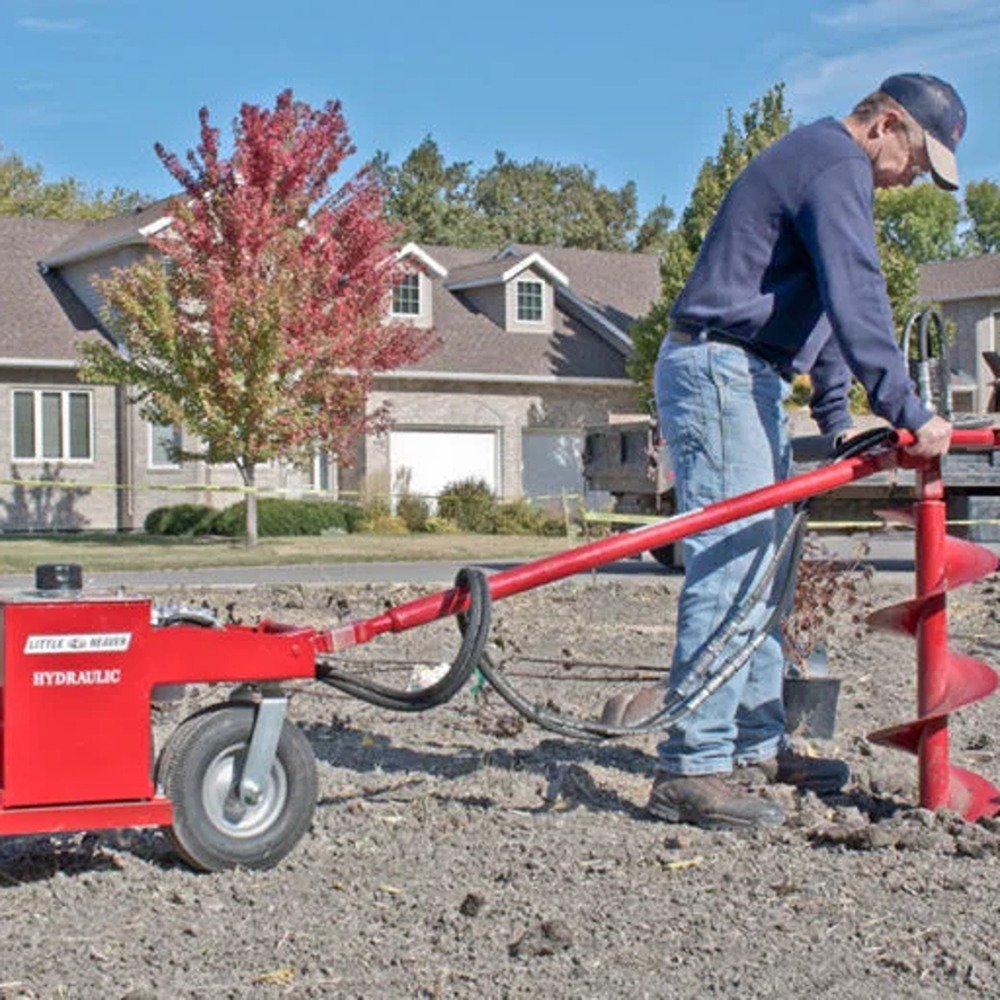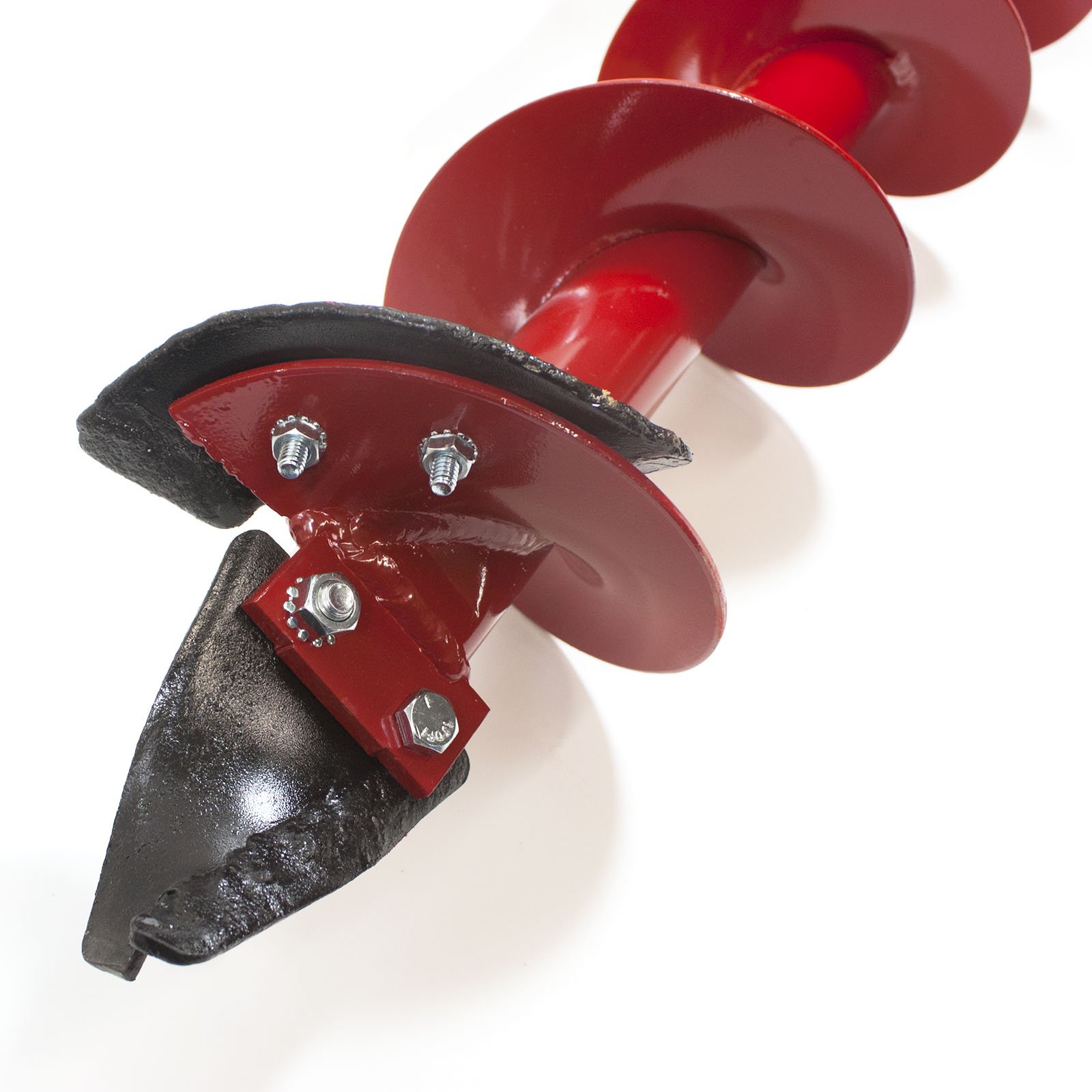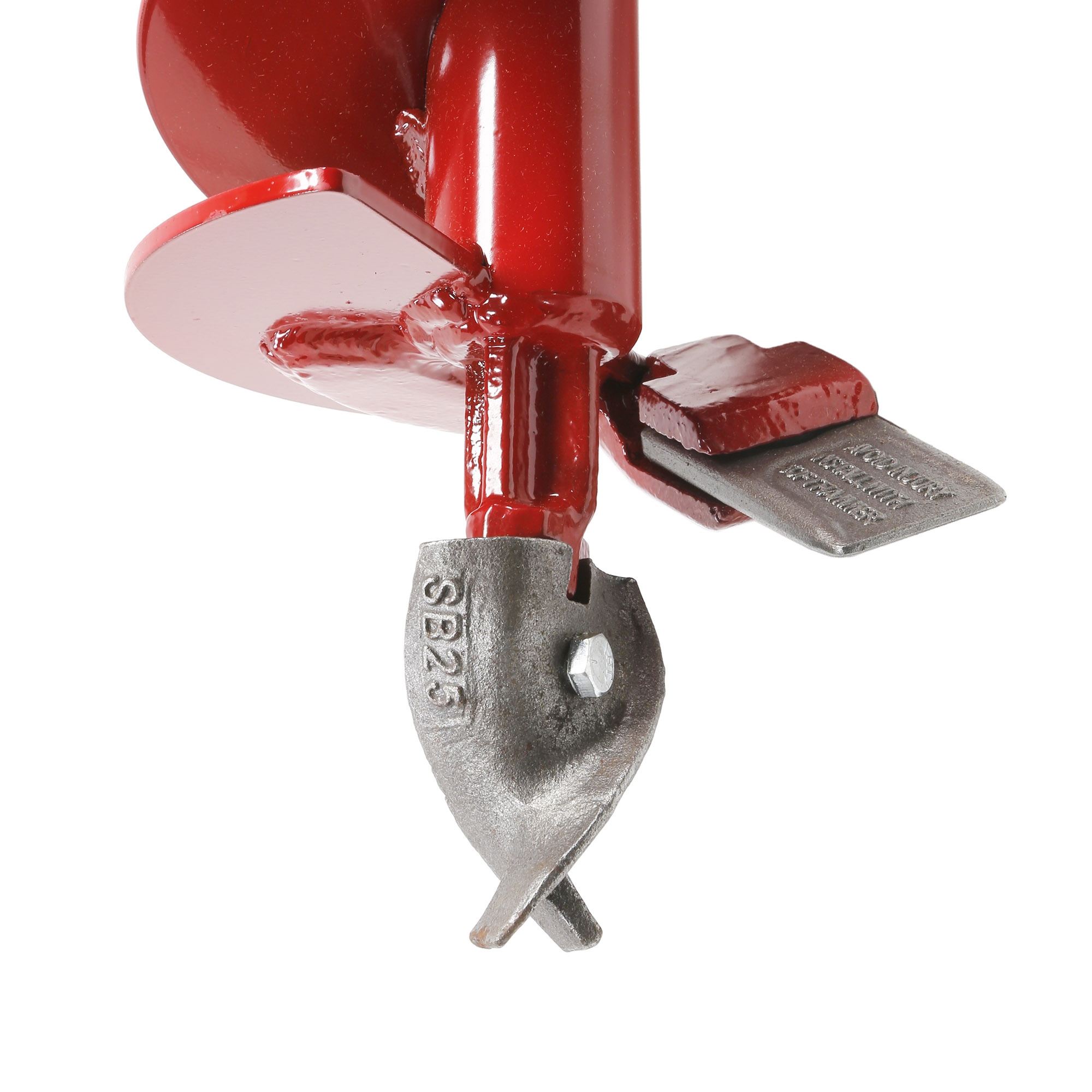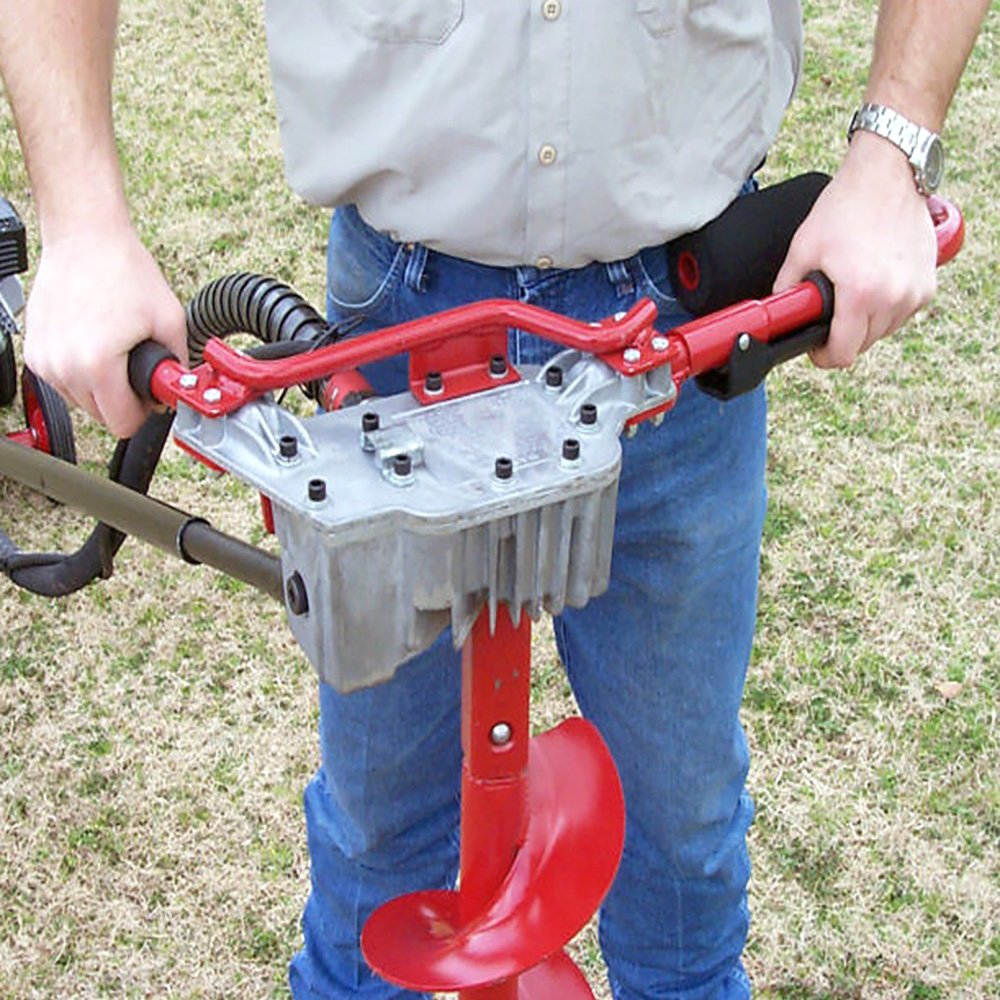| Name |
Definition |
| Adapter (Adaptor) |
A device which fits into the output socket of the Little Beaver gearbox
and allows the use of other brand augers or attachments.
|
| Anchor Handle |
A type of attachment for the Little Beaver hydraulic power source which is
designed for the installation and removal of a mobile home or utility
anchors. It is not suitable for diggings holes because of its very low
rpm.
|
| Auger |
The part which actually digs the hole. As it turns, it removes the soil
from the hole and augers it up the flighting.
|
| Auger Extensions |
These are augers that have a female socket at the bottom which attaches to
the top of the auger, allowing the user to increase the depth of the hole.
Auger stop - A U-shaped fork with a handle that is inserted around the
center tube of an auger or extension to prevent it from falling back into
the hole.
|
| Big Beaver |
An all hydraulic, mast-type auger drill rig which is used in conjunction
with the PS-18 hydraulic power source. This is the most powerful earth
drill in the Little Beaver product line.
|
| Bit |
A generic term that is commonly applied to both the auger and to the
cutting blades. At Little Beaver, we use more precise terms to distinguish
the auger, the replaceable point, and the replaceable blade.
|
| Blade |
The replaceable cutting tool which is attached to the flighting in the
case of the standard snap-on auger, or installed in the blade holder in
the case of the heavy-duty rock auger.
|
| Bucket Auger |
An auger that is built in the form of an open bucket and is designed to
fill with soil as it turns. When full, it must be lifted from the hole and
emptied. It usually takes several repetitions of this sequence to dig a
complete hole. It is not suitable for use in very loose sand (it will pour
out) or in rocks.
|
| Carbide Blade |
A cutting blade that has tungsten carbide cutting edges applied to the
cutting surface, usually with silver solder. Little Beaver has two styles
of carbide blades. One style fits the standard snap-on auger. This carbide
blade bolts on in place of the point and is different for each diameter of
auger. The other style is for the heavy-duty rock auger (Pengo¨ style).
This one will fit any size auger (some sizes require two or more blades).
|
| Centrifugal Clutch |
The style of the clutch mechanism used on the Little Beaver mechanical
earth drill. It disengages from the drive train when the engine is at
idle, preventing the auger from turning.
|
| Core |
The inner wound cable within the flexible shaft that spins with the engine
and transmits power to the gearbox.
|
| Drill Chuck Attachment |
An attachment that allows the Little Beaver earth drill to be used with
wood or masonry bits to drill small diameter holes in fence posts, decks,
or brick.
|
| Earth Auger |
See "Auger." |
| Earth Drill |
The power unit, whether mechanical or hydraulic, which provides power to
turn the earth auger. Otherwise known as a post hole digger or just
digger.
|
| Earth Saw |
A term to describe the technology that is used on the Kwik-Trench models
of earth trenchers. Rather than use a digging chain, they use a rotating
wheel with teeth to "saw" through the ground.
|
| Flexible Shaft |
The power shaft or cable that connects the engine to the gearbox on the
mechanical drive models of Little Beaver Earth Drills.
|
| Flexible Shaft Core |
See "Core." |
| Flexible Shaft Housing |
The outer casing of the flexible shaft assembly. The core is contained
inside of it and is lubricated with a special grease.
|
| Flighting |
The spiral (helix) of steel which is wound around the center tube (barrel)
of the auger. It "augers" the soil from the hole while digging.
|
| Hard Facing |
The tungsten carbide wear material which is applied to the edges of the
standard blades and points. It can optionally be applied to the flighting
of an auger.
|
| Helper Handle |
An optional handlebar that can be used with the Little Beaver hydraulic
one-man handle. It allows a second person to help in lifting large augers
from the ground.
|
| Hollow Stem Augers |
Special augers which allow a soil sample to be taken through the center
without completely removing the string of augers from the hole. Suitable
only for use with the Big Beaver auger drill rig.
|
| Horizontal Boring |
Drilling a hole horizontally under a sidewalk or driveway using the Little
Beaver Earth Drill and a wet or dry type accessory kit.
|
| Horizontal Boring (Dry) |
Drilling horizontally using the dry kit, which consists of a 5-foot long
auger, universal joint extension, and key. This kit is easy to set up but
is limited to 5 feet in distance.
|
| Horizontal Boring (Wet) |
Drilling horizontally using the wet kit, which consists of a water swivel,
adapter, special cutting bit, and key. This kit is more cumbersome to set
up, but it can be used to bore up to 50 feet in distance. Not designed for
use under roads or highways. Lift square - An accessory that attaches to
the top of an auger or extension and has a loop that can be hooked to the
tripod winch for lifting a string of augers and extensions from the hole.
The lift square is included as part of the tripod kit.
|
| Mini Trencher |
A common term for the Kwik-Trench style of earth trencher. These types of
trenchers typically use small engines of 8 HP or less and are not
self-propelled.
|
| Pengo™ Auger |
A style of auger cutting head originally designed by the Pengo Corporation
which uses replaceable cutting blades held in place with a rubber lock. It
is a more aggressive and rugged design that is useful in rocky soils.
|
| Point |
The replaceable tip bolted to the bottom end of the auger. |
| Safety Drive Hammer |
A 140-pound drop hammer which is used in conjunction with the Big Beaver
auger drill rig and soil sampling kit to collect samples for determining
the properties and characteristics of the soil. This device can be used to
perform the Standard Penetration Test (SPT) as prescribed by ASTM D 1586.
|
| Sidewalk Auger Kit |
See "Horizontal boring (Dry)." |
| Side Cutter Blade |
See "Blade". |
| Small Diameter Augers |
Little Beaver augers which are smaller than 4 inches in diameter. They use
a different type of construction than the larger augers and usually
require an adapter.
|
| Snap-On |
The method of auger connection used by Little Beaver which uses an
enclosed snap button to secure the auger to the gearbox. Also refers to
the standard Little Beaver auger design with bolt-on points and blades.
|
| Split Tube Sampler |
A type of soil sampling device, used in conjunction with the Big Beaver
auger drill rig and soil sampling kit, which is used to take an
undisturbed sample of the soil. The soil is pushed up into a tube that can
then be separated lengthwise into two halves for inspection and removal of
the sample. It can also be used to perform the Standard Penetration Test
(SPT) as prescribed by ASTM D 1586.
|
| Telescoping Torque Tube |
A one-piece torque tube used with the Little Beaver Hydraulic Earth
Drills. It will extend or collapse but will not come apart.
|
| Teeth |
Another term sometimes applied to cutting blades and points. |
| Throttle Cable |
The cable that runs from the throttle control lever, down the length of
the flexible shaft, to the engine on the mechanical Little Beaver Earth
Drill.
|
| Torque Tube |
The steel tube that connects the handle to the engine and prevents
"kick-back" when the auger encounters an underground obstruction. The
torque tube is standard equipment on all Little Beaver models except the
towable hydraulic unit.
|
| Tube Extension |
A universal auger extension that has no flighting. The tube extension can
be used with any size auger to increase the digging depth.
|
| Water Drilling Kit |
See "Horizontal boring (Wet)." |




